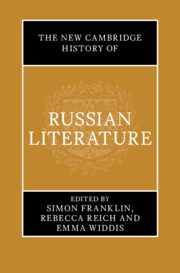Book contents
- The New Cambridge History of Russian Literature
- The New Cambridge History of Russian Literature
- Copyright page
- Contents
- Figures
- Contributors
- Acknowledgements
- On Transliteration, Names, and Dates
- Introduction
- History 1 Movements
- History 2 Mechanisms
- History 3 Forms
- 3.1 Forms before Genres
- 3.2 Folk Genres
- 3.3 Verse I
- 3.4 Drama I
- 3.5 The Novel I
- 3.6 The Short Story
- 3.7 Drama II
- 3.8 Verse II
- 3.9 The Novel II
- 3.10 Self-Writing
- 3.11 (Plat)forms after Genres
- Boxes 5 Critical Frames
- Boxes 6 Literature beyond Literature
- History 4 Heroes
- Index
- References
3.2 - Folk Genres
from History 3 - Forms
Published online by Cambridge University Press: 31 December 2024
- The New Cambridge History of Russian Literature
- The New Cambridge History of Russian Literature
- Copyright page
- Contents
- Figures
- Contributors
- Acknowledgements
- On Transliteration, Names, and Dates
- Introduction
- History 1 Movements
- History 2 Mechanisms
- History 3 Forms
- 3.1 Forms before Genres
- 3.2 Folk Genres
- 3.3 Verse I
- 3.4 Drama I
- 3.5 The Novel I
- 3.6 The Short Story
- 3.7 Drama II
- 3.8 Verse II
- 3.9 The Novel II
- 3.10 Self-Writing
- 3.11 (Plat)forms after Genres
- Boxes 5 Critical Frames
- Boxes 6 Literature beyond Literature
- History 4 Heroes
- Index
- References
Summary
This chapter provides a short history of folklore collection and an overview of the genres privileged by Russian folklorists. In the early 1800s, folklorists began writing down, editing, and publishing creative oral performance, primarily that of peasants, because it was thought that these performances reflected ancient traditions that had been passed down for centuries. In the course of transforming oral culture into print collections, genres were identified and codified. The epic (bylina) and the fairytale (skazka) were among the genres most prioritised. Their particular formal features served to anchor a diverse genre system that included historical songs, religious verses, legends, and mythological stories. The chapter identifies characteristic events and stock characters, as well as features of style, structure, and performance typical of these genres of narrative folklore. It concludes by commenting on the reciprocal relationship between folklore and literature.
- Type
- Chapter
- Information
- The New Cambridge History of Russian Literature , pp. 482 - 497Publisher: Cambridge University PressPrint publication year: 2024

